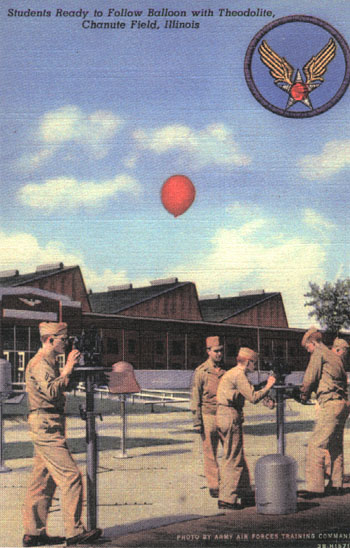Pibal publications, articles and software of interest on the Web.

Women in the Weather Bureau During World War II, Edited by Kaye O'Brien & Gary K Grice, A National Weather Service Publication. A must read accounting and history of service by a number of women in the war years with links to photos in the NWS photo archive.
Manual Para la Observasion de Sondeos de Globo Piloto con un Thedolito (Manual for the observation of pilot balloons with a theodolite - in Spanish) This manual was produced by José M. Gálvez for the South American Low Level Jet Experiment, which is part of the PACS project. It also downloadable in MS Word Format along with a host of other information in Spanish from the Salljax site. The Pan American Climate Studies Sounding Network (PACS-SONET) is a large meteorological user of Pilot Balloon Observation data. They set up pilot balloon stations (as well as more modern methods as location and funding permits) as well as train Meteorologist and Met Techs in upper air observations and processing.
Federal Meteorological Handbook No. 3 Rawinsonde and Pibal Observations FCM-H3-1997 This is a Handbook that contains information on Pibal Observations as well as Rawinsonde (radio tracked observations of radiosonde equipped balloons) operation. The link is to the title page and foreword. Click on the Table of Contents link on the bottom of the page to navigate the document.
Computing the Rate Of Ascent of a Pibal by Mike Bien, Balloonlife Mag. 07, 1995 This is an article with a formula and method that you can use to determine the rate of ascent of balloon (filled with helium). Note that there is a typo in the definition for L. It should read Where L = Free Lift (grams)
Computing Wind Speed Aloft Using a Pibal by Mike Bien, Balloonlife Mag. 08, 1995 This is the follow-up article to the item above. Unfortunately it does not give you direction information or give you methods of determining it.
Pibal information, available? in libraries, repositories etc. and other interesting reading. Unfortunately all of items below are out of print. They can be seen at older university libraries and federal document depositories as well as the NOAA archives (if you are an NOAA employee).
Federal Meteorological Handbook No. 5 Winds-Aloft Observations September 1, 1972. This handbook was replaced by Handbook No. 3 above. It has more information if Pibal use that the 1997 document. It includes information on Pibal Plotting and Graphing Sets, and using balloon lighting units.
Manual of Winds-Aloft Observations, Circular 0 September 1959, updated April 1964. This handbook was replaced by Handbook No. 5 above. It has more extensive information on Pibal use than the above. It also contains information on use of a Marine Pibal Theodolite.
Instructions for Making Pilot Balloon Observations 1928 (and same title 1942, addition of Circular 0 in title). These two publications are difficult to find. The predate common use of Radiosondes - radio tracked balloons and in the case of the 1928 issue, the theodolites did not utilize micrometers. For the hard core enthusiast these are worth tracking down.
Invention of the Meteorogical Instruments, by W.E. Knowles Middleton, John Hopkins Press, Baltimore, 1969. This book is hard to find but also worth the trouble. It contains interesting reading for anyone interested in the history of weather related instrumentation. It has chapters covering the barometer, thermometer, instruments for measuring humidity, the rain gauge and barometer, windvane and anemometer, measurement and duration of sunshine, Upper winds, cloud height, and motion, Upper-air soundings with and without telemetery and more. 348 pages and some nice illustrations.
Meteorological Instruments, Third Edition - Revised, W. E. K. Middleton, A. F. Spilhaus, University of Toronto Press, 1953. This book is also hard to find. It has an informative section on upper air soundings, with good photos and illustrations and the mathematics behind the measurements. This volume is written as a general text on instruments. It is an excellent primer on meteorological instruments and their operation.
